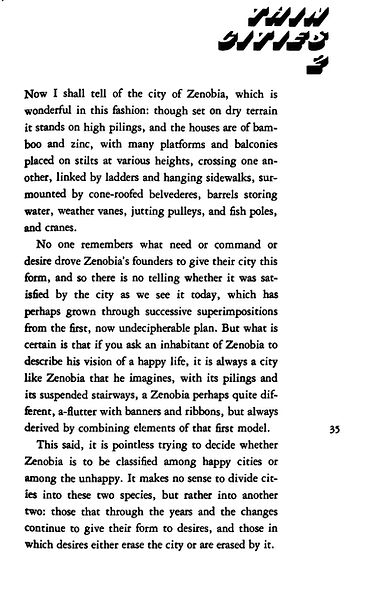Module 4:Frame VS. Field
Introduction
In this module, an old quad has been constructed in Rhino, then Illustrator and Photoshop have been used to edit one isometric view and two perspective view of a new version of the old quad based on Invisible city Zenobia.
Thin Cities 2: Zenobia

The city of Zenobia is the city of continues change where it grows through successive superimpositions and elements in different period stay over time. According to the description, Zenobia sits on a dry terrain, there are water barrels to store water; but at the meanwhile, the city also sits on high pilling and fish poles are found in the city. So I think the city might once be a village sits on water, that was why the buildings are on high pilling. As the city form changed over time, the terrain went dry.
Rhino

Stage 1. Building up the column.

Stage 2. Mirror the column.

Stage 3. Array the old quad

old quad
Symbols
Illustrator

Heading 35i

Heading 35i
This isometric view with notations indicated the movement throughout Marco Polo’s visit in the city Zenobia.
Perspective views

Perspective 1
This view is interesting and suitable for my scene. It provides a nice view of the quad, with light and shadow, it also has a space to allow creation on the background.

Perspective 2
This scene is comparatively darker, which is good for the dark atmosphere designed for the second perspective. It portraits a
view straight through the quad which shows a large space of the quad.
Photoshop

Perspective 1
Fishing town
The perspective one is Marco Polo’s first glimpse of the city, which was an illusion of what the city was like before. What he saw was a fishing town with people selling fish, people chatting and having social life in the
quad, these working class people describe their city as a happy place. At the background, there are buildings and people catching fish. The sculpture of Poseidon on the capital showed how this fishing town worships the sea god. This perspective emphasised the joyful people in the foreground.

Perspective 2
Abandoned town
Before Marco Polo walked out of the city, he looked back and gave the city one last look. However, what he saw was this deserted quad with broken water barrels, cracked walls, fish bones, and even the Poseidon sculpture on the ground. However, the emphasis of this scene is the house in the background, sitting on pilings on a try terrain. This, is reality, which gives an idea of how Zenobia grow through successive superimpositions.
Final Isometric view

The isometric map indicates Marco Polo’s movement and mood throughout his journey in Zenobia. Marco Polo entered Zenobia from the back, he was just passing by and he did not fit into the working class, so he walked fast. Halfway throw his journey, he was influenced by the peaceful and harmonious atmosphere in the quad, he slowed down and felt peaceful. Right before he exits Zenobia, he wanted to take one last glimpse of the city, he turned back, what he saw was an abandoned quad. He realised that what he saw, in the beginning, was an illusion of what Zenobia looked like before, with the great contrast between the two scenes, Marco Polo felt heavy and wondered what really happened here; was this a happy place or just a place that people wanted to erase.